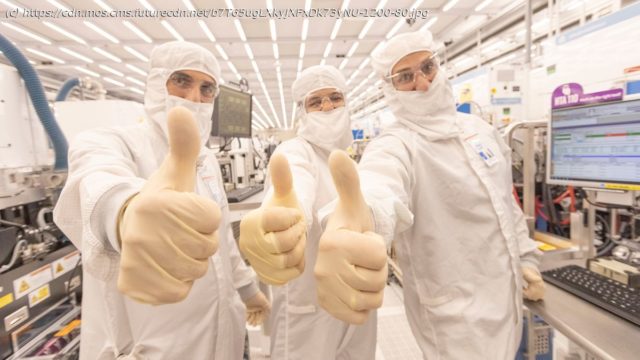One of our favourite pieces from this year, originally published October 31, 2022:Open-chip surgery is a thing. And it involves ion beams. This came as news to me as I wandered through Intel's la
One of our favourite pieces from this year, originally published October 31, 2022:
Open-chip surgery is a thing. And it involves ion beams. This came as news to me as I wandered through Intel’s lab in Haifa, Israel, and no sooner had I learned about its existence I came face to face with the impressive machine that performs the surgery. It’s surprisingly small, quiet even, and it has one of the coolest names imaginable: Focused Ion Beam, or FIB for short.
When it comes to fixing a faulty processor, there’s no easy way to do it. I should have known that performing bypass surgery on chips with transistors only nanometers across would require intense effort and precision. Yet it’s so easy to disregard what goes into making a chip when you’re regularly benchmarking heaps of them like I am.
But as I’m standing in the FIB lab, watching an engineer hone in on a microscopic area inside a chip and alter how it functions with extreme accuracy, the intense effort that goes into each stage of the chipmaking process hits me like a ton of bricks. The fact that any of these chips exist, and we get new ones every single year, is mind boggling.
The reason I’m here at Intel’s Israel Development Center (IDC) is to get a glimpse of what it takes to develop, manufacture, and validate a processor. Intel’s IDC is where a lot of the legwork takes place in the creation of its processor architectures, including many of those familiar to PC gamers over the years. Skylake, Kaby Lake, Coffee Lake, Ice Lake, Rocket Lake, Alder Lake, and now Raptor Lake chips—these all originate with IDC.
So you could say it’s a good place to learn about the intricacies of building a processor from scratch.IDC
IDC, here we come. (Image credit: Intel) (opens in new tab) »You have a spare tyre in your car, I have a spare block in my CPU. »
Our tour begins at the end: the Post Silicon Validation Lab. This is where engineers team up with manufacturers, OEMs, and partners to ensure that Intel’s upcoming chips work well in their systems. While most PC builders will work to their own spec, most large-scale system builders are working to Intel’s.
To one side of me, Microsoft Surface laptops with the latest mobile chips. To the other, two Alienware desktops running Raptor Lake. These systems were in the lab in September, so at least a month in advance of the 13th Gen’s launch, if not long before our hoard of journalists were bused in.
At the end of the room sits a drawer of goodies, including two early Raptor Lake samples. Though what’s more out of the ordinary in this lab is the PCIe 5.0 test card. When Intel adopted Gen 5 for its 12th Gen CPUs for the first time, there were no add-in cards capable of utilising Gen 5 ports. Intel had to make one for itself. It seems so obvious in that testing environment that such a device would be required, but I hadn’t thought about how testing new features on your unannounced or high-performance products often means building cutting-edge testing vehicles, too. It’s not a sleek looking device, but it’s not particularly shoddy either, and I’m told it gets the job done.
Intel’s PCIe 5.0 test card is a pretty nifty-looking piece of gear. (Image credit: Intel) (opens in new tab)
This validation lab is also where we hear of Alder Lake’s first boot on Windows. The 12th Gen chips were the first to use Intel’s new hybrid architecture: a slightly less homogenous approach to computing utilising both Performance-cores (P-cores) and Efficient-cores (E-cores) on a single die. This disparate build requires a different approach to OS optimisation, and Intel’s engineers made no bones about the hours it took to boot an Alder Lake CPU into Windows for the first time.
The first time Intel booted the chip was from the very building I was standing in. But the 12th Gen chip wasn’t. The chip was located over 6,000 miles away in the US. A completely remote first boot.
Could you send us one of these adjustable chassis please, Intel? (Image credit: Intel) (opens in new tab)
We head out the lab the way we came in, back into a room lined with test benches for aisle after aisle. This is Intel’s stress and stability area: where CPUs are put through their paces to see if they’re ready to ship or if another stepping is required. Intel has some of the most modular and impressively compact test benches I’ve ever seen, and I’m only slightly (very) jealous of them. The PC Gamer test benches are a mess by comparison—functional (mostly) but messy. These are gorgeous, modular and compact by comparison.
Intel is running what must be hundreds of systems with bespoke hardware, automated programs, and cooling. The liquid cooling loops throughout Intel’s labs are actually plumbed into the wall, for goodness’ sake, which is the first time I’ve seen anything of the sort.
There are rows and rows of test benches just like this. (Image credit: Intel) (opens in new tab)
As we’re walking through the aisles of test benches, there are heaps of recognisable codenames stuck to each and every one: RPL (Raptor Lake) and ADL (Alder Lake) among them. There is more often than not a familiar benchmark running on a constant pre-programmed loop, too. 3DMark is being used to measure the might of these chips, and we’re told that engineering samples from different stages have variable standards set for stability in order to get the go-ahead to move to the next stage of the operation.
Then we’re onto power and thermal performance testing, though it’s not so much next in a chip’s life as it’s just where we’re ferried to next. I’m told there’s plenty of communication between teams and a constant back and forth on samples, so it’s less of the one-way street to validate a chip as you might imagine it to be.
Most of the gear in power and thermal testing will be familiar to PC gamers. (Image credit: Intel) (opens in new tab)
This is where a lot of debugging for future chips happens in regards to applications that customers, like you and me, might actually use.
Gaming is the benchmark of choice for many of the chips being tested while we’re in the lab. Here Intel is pairing its CPUs, namely Raptor Lake at this time, with Nvidia and AMD graphics cards. It has a whole lot of them, and lots of consumer motherboards, lining the workbenches alongside accurate thermal and power monitoring tools. A handful of high-end cards were being tested in Shadow of the Tomb Raider while I was in the room, with intermittent monitors flickering to life with graphs showing voltage curves and temperatures.
Intel uses some heavy-duty testing gear mixed in with off-the-shelf parts. (Image credit: Intel) (opens in new tab)
The engineers here are also using standard CPU coolers, to better replicate how these chips will be actually setup out in the wider world.
All roads lead to the Class Test Lab. Every engineering sample spotted in a database or sold on eBay over the past few years once made its way through here. We’re told it’s the most engineering focused lab at Intel, but it’s said with a smirk. It has the desired effect of getting a rise out of our Intel tour guides from other departments, at least.
Everywhere you look in the class test lab is another rack of chips being tested. (Image credit: Intel) (opens in new tab)
In this lab, which is lined with racks of test machines and containers with multiple generations of samples within, Intel is able to classify blocks independently of each other. « You have a spare tyre in your car, I have a spare block in my CPU, » an engineer tells us.
Each block in a CPU is a functional component. They range in size from the smallest of buses to a whole core component. Having the ability to classify these on a block by block level offers flexibility in both construction and troubleshooting, so it’s an important step in speeding up the design and validation process.
Trays and trays of chips awaiting testing. (Image credit: Intel) (opens in new tab)
If it’s broken, we’ll find it.
Electrical validation offers another way to check a processor for errors. This is primarily a job for robots, which work through trays of chips, installing them into a motherboard one by one, and run various scenarios and configurations to check for errors. We’re stood by some of Intel’s older testing tools, which require some human calibration to prevent a robot arm jabbing its suckered finger into the socket. Though close by is a brand new machine. This fancy number, we’re told, removes the need for even more human configuration, allowing for swifter, more comprehensive data gathering.
Intel even has a robot that slots RAM sticks into a motherboard. The future is now. (Image credit: Intel) (opens in new tab)
As you might already be noticing, there are many steps to validating a processor before its final design or release. But what happens when one of these steps finds something isn’t working as intended? That depends on the error, of course, but when an error is found the chip heads to a department called Component Debug.
Home
United States
USA — software Inside Intel: here's what goes into making a cutting-edge gaming CPU






